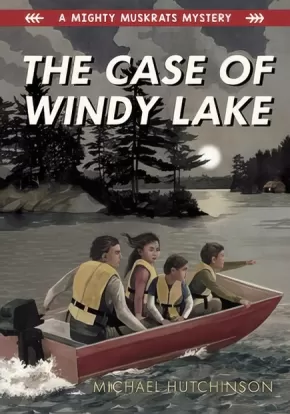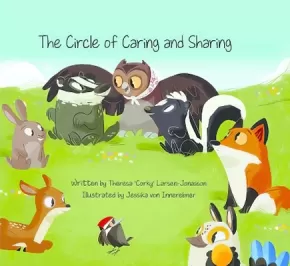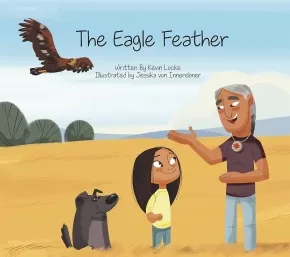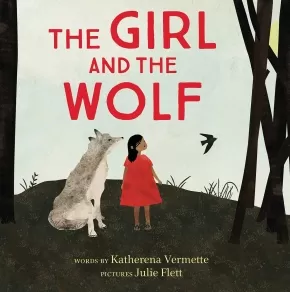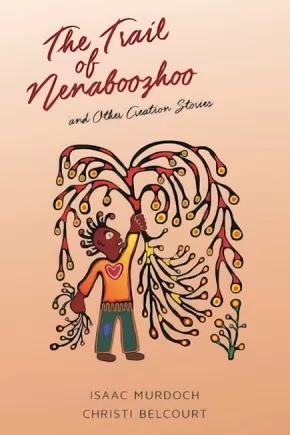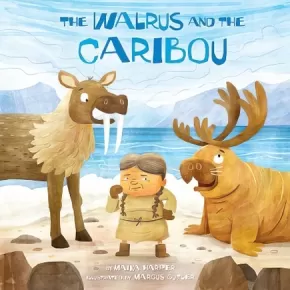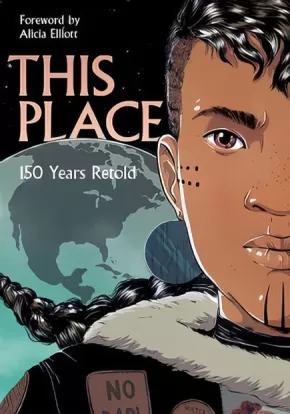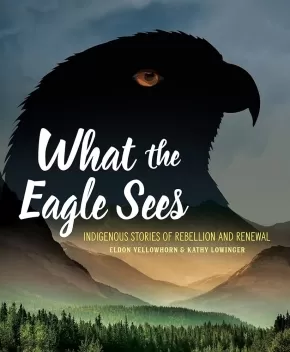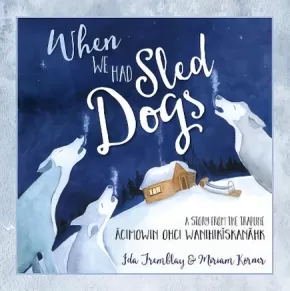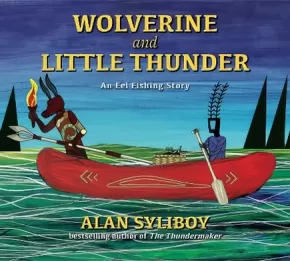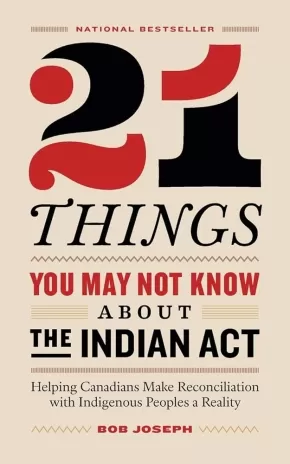
Canadian Indigenous Resource Lists
196
-
210
of
473 Results;
Sort By
Go To
of 32
The Bear's Medicine / Sus Yoo
$19.95
Artists:
Format:
Hardcover
Text Content Territories:
Indigenous Canadian; First Nations; Dene; Dakelh (Carrier);
ISBN / Barcode: 9781926886572
Synopsis:
Synopsis:
How does a mother bear feed her babies? Off the land, of course.
A mother bear shares with her cubs how to be grateful for all they have in the natural world. The Bear's Medicine shows the interconnectedness of all things in the world they live in and how each season brings changes and blessings for the bears. It is a story of a mother's love for her children as she teaches them how to survive.
Written in English and Dakelh.
Awards
- Winner of the 2020-2021 First Nation Communities Read's Indigenous Literature Award
Reviews
"In this bilingual story, a mother bear teaches her cubs how to live in relationship to the land. Emphasizing gratitude, interdependence, and ancestry, Cree/Dakelh author and artist Gauthier conveys the wisdom of growing up and cultural inheritance through the movements of a bear family.... Valuable for its rich imagery and simple yet multifaceted storytelling, this stands as a beautifully told, #ownvoices offering that focuses less on plot and more on fascinating concepts." - Kirkus Reviews
Educator Information
Recommended for ages 6-8.
Keywords: bear, Indigenous, interconnectedness, medicine, nature, animals.
Recommended in the Canadian Indigenous Books for Schools 2020/2021 resource list as being useful for grades 1-3 in these areas: Science and Social Studies.
Additional Information
32 pages | 8.00" x 8.00" | Dakelh translation by Danny Alexis and Theresa Austin
The Case of Windy Lake
$11.95
Format:
Paperback
Text Content Territories:
Indigenous Canadian; First Nations; Cree (Nehiyawak);
ISBN / Barcode: 9781772600858
Synopsis:
Synopsis:
The Mighty Muskrats won’t let a mystery go unsolved!
Sam, Otter, Atim, and Chickadee are four inseparable cousins growing up on the Windy Lake First Nation. Nicknamed the Mighty Muskrats for their habit of laughing, fighting, and exploring together, the cousins find that each new adventure adds to their reputation. When a visiting archeologist goes missing, the cousins decide to solve the mystery of his disappearance. In the midst of community conflict, family concerns, and environmental protests, the four get busy following every lead. From their base of operations in a fort made out of an old school bus, the Mighty Muskrats won’t let anything stop them from solving their case!
Awards
- The Case of Windy Lake was the co-winner in Second Story Press’ 2018 Indigenous Writing Contest!
Reviews
"Chickadee's rez-tech savvy pairs well with her cousin Otter's bushcraft skills, and, along with Atim's brawn and brother Samuel's leadership, the four make a fine team. From Cree author Hutchinson, an Indigenous version of the Hardy Boys full of rez humor." — Kirkus, December 2018
"The Case of Windy Lake is a smart and thought-provoking mystery for middle-grade readers." — Foreword Reviews
Educator & Series Information
This fun and adventurous series, A Mighty Muskrat Mystery Series, puts an Indigenous spin on the classic Hardy Boys and Three Investigators books.
Recommended for ages 9-12.
Subjects & Themes: Environment (Protection, Protest); Civil Rights; Indigenous (Rights to Land, Rights to Natural Resources, Knowledge, Protection of Cultural Ceremonies).
Recommended in the Canadian Indigenous Books for Schools 2019-2020 resource list as being useful for grades 6-9 in the following subject areas: English Language Arts and Social Studies.
This book is available in French: Le Disparu de Lac-aux-Vents: Une enquête des rats musclés
Additional Information
134 pages | 5.25" x 7.50"
The Circle of Caring and Sharing
$11.95
Artists:
Format:
Hardcover
Text Content Territories:
Indigenous Canadian; First Nations;
ISBN / Barcode: 9781989122235
Synopsis:
Synopsis:
When two foxes, who are best friends, have a fight it upsets the whole community of animals. Kokom the Owl knows just what to do and brings together all the animals and holds a Sharing Circle.
Educator Information
This book is an adaptation of the book The Sharing Circle for a younger audience (ages 4-6). Explores topics of respect, communication, relationships. Useful social-emotional learning resource.
Includes a page of Plains Cree animals and their phonetic pronunciations at the end of the book.
Recommended in the Canadian Indigenous Books for Schools 2020/2021 resource list as being useful for grades K-3 in these areas: English Language Arts.
This book is available in French: Le cercle d'aide et de partage
Additional Information
32 pages | 9.00" x 8.00"
The Eagle Feather
$11.95
Artists:
Format:
Hardcover
Text Content Territories:
Indigenous American; Native American; Sioux; Lakota; Indigenous Canadian; First Nations; Sioux; Lakota;
ISBN / Barcode: 9781989122228
Synopsis:
Synopsis:
When we look up to the sky and see a beautiful eagle soaring by, we may stop to appreciate its graceful sight, but, as Kevin Locke explains, eagles also have powerful teachings to offer. In this book, Kevin shares with us that each feather on the eagle's wing represents a virtue that we can all learn from.
Educator Information
This book is an adaptation of the book Dawn Flight for a younger audience (ages 4-6). Explores Indigenous ways of knowing and being.
A page at the back of the book includes a few words in Lakota.
Suggested for Ages 4-6.
Recommended in the Canadian Indigenous Books for Schools 2020/2021 resource list as being useful for grades K-2 in this area: Social Studies.
This book is available in French: La plume d'aigle
Additional Information
26 pages | 9.00" x 8.00"
The Ghost Collector
$11.95
Format:
Paperback
Text Content Territories:
Indigenous Canadian; First Nations; Cree (Nehiyawak);
ISBN / Barcode: 9781773212951
Synopsis:
Synopsis:
Ghosts aren’t meant to stick around forever…
Shelly and her grandmother catch ghosts. In their hair.
Just like all the women in their family, they can see souls who haven’t transitioned yet; it’s their job to help the ghosts along their journey. When Shelly’s mom dies suddenly, Shelly’s relationship to ghosts—and death—changes. Instead of helping spirits move on, Shelly starts hoarding them. But no matter how many ghost cats, dogs, or people she hides in her room, Shelly can’t ignore the one ghost that’s missing. Why hasn’t her mom’s ghost come home yet?
Rooted in a Cree worldview and inspired by stories about the author’s great-grandmother’s life, The Ghost Collector delves into questions of grief and loss, and introduces an exciting new voice in tween fiction that will appeal to fans of Kate DiCamillo’s Louisiana’s Way Home and Patrick Ness’s A Monster Calls.
Reviews
“Allison Mills’ The Ghost Collector is both delightful and haunting. A delicious blend of the supernatural and the very real. Mills has great respect for her audience. Taking great care to keep the narrative moving while never simplifying the novel’s ideas and themes of loss. The result is a nuanced study in empathy for both the characters and the readers.” — Sunburst Award Jury, 08/20
“Simple language makes The Ghost Collector accessible to its tween audience while introducing sophisticated concepts. In Shelly, Mills has created a believable, likeable character who learns important life lessons about the future in the rich context of her cultural past.” —CM Reviews, 09/20/19
Educator Information
Recommended for ages 10+
Recommended in the Canadian Indigenous Books for Schools 2020/2021 resource list for grades 6 to 8 for English Language Arts.
Additional Information
192 pages | 5.50" x 7.50"
The Girl and the Wolf
$22.95
Artists:
Format:
Hardcover
Text Content Territories:
Indigenous;
ISBN / Barcode: 9781926886541
Synopsis:
While picking berries with her mother, a little girl wanders too far into the woods. When she realizes she is lost, she begins to panic. A large grey wolf makes a sudden appearance between some distant trees. Using his sense of smell, he determines where she came from and decides to help her. Through a series of questions from the wolf, the little girl realizes she had the knowledge and skill to navigate herself—she just needed to remember that those abilities were there all along.
Synopsis:
An empowering Indigenous twist on a classic wolf narrative.
While picking berries with her mother, a little girl wanders too far into the woods. When she realizes she is lost, she begins to panic. A large grey wolf makes a sudden appearance between some distant trees. Using his sense of smell, he determines where she came from and decides to help her. Through a series of questions from the wolf, the little girl realizes she had the knowledge and skill to navigate herself—she just needed to remember that those abilities were there all along.
Reviews
"The Girl and the Wolf is about a young girl who wanders too far in the woods and realizes she is lost. A large grey wolf appears, trying to help her find her way back. Through this interaction with the wolf, the girl realizes she has the knowledge and skills all along." - The Dalai Lama Center
"The Girl and the Wolf is about a young girl who wanders too far in the woods and realizes she is lost. A large grey wolf appears, trying to help her find her way back. Through this interaction with the wolf, the girl realizes she has the knowledge and skills all along." - The Dalai Lama Center
Educator Information
Themes: independence, children, knowledge, power, strength, nature, instincts, survival skills.
Themes: independence, children, knowledge, power, strength, nature, instincts, survival skills.
Recommended in the "Canadian Indigenous Books for Schools 2019-2020" resource list as being useful for K-3 students in these subject areas: English Language Arts, Social Studies
Additional Information
32 pages | 8.00" x 8.00"
32 pages | 8.00" x 8.00"
The Grizzly Mother
$23.00
Artists:
Format:
Hardcover
Text Content Territories:
Indigenous Canadian; First Nations; Gitxsan (Gitksan);
ISBN / Barcode: 9781553797760
Synopsis:
Synopsis:
An engaging look at how the animals, people, and seasons within an ecosystem are intertwined.
To the Gitxsan people of Northwestern British Columbia, the grizzly is an integral part of the natural landscape. Together, they share the land and forests that the Skeena River runs through, as well as the sockeye salmon within it. Follow mother bear as she teaches her cubs what they need in order to survive on their own.
The Mothers of Xsan series uses striking illustration and lyrical language to bring the poetry of the Xsan ecosystem to life.
Awards
- Animal Behavior Society's Outstanding Children's Book Award
- 2020 Manuela Dias Design and Illustration Awards, Children's Illustration winner
Educator & Series Information
Recommended for ages 9 - 12.
This is the second book in the Mother of Xsan series, which uses striking illustration and lyrical language to bring the poetry of the Xsan ecosystem to life.
Recommended in the "Canadian Indigenous Books for Schools 2019-2020" resource list as being useful for students in grades 2-5 in these subject areas: English Language Arts, Science, Social Studies.
Additional Information
32 pages | 6.50" x 10.00"
The Trail of Nenaboozhoo: and Other Creation Stories (1 in stock, in reprint)
$25.00
Format:
Paperback
Text Content Territories:
Indigenous Canadian; First Nations; Anishinaabeg;
ISBN / Barcode: 9781928120193
Synopsis:
Synopsis:
Nenaboozhoo left us many gifts.
Nenaboozhoo, the creator spirit-being of Ojibway legend, gave the people many gifts. This collection of oral stories presents legends of Nenaboozhoo along with other creation stories that tell of the adventures of numerous beloved animal spirits. The Trail of Nenaboozhoo is a book of art and storytelling that preserve the legends of the Anishinaabe people. Each story is accompanied by strikingly beautiful illustrations by revered Indigenous artists Isaac Murdoch and Christi Belcourt.
Educator & Series Information
From the Forward, by Isaac Murdoch:
"Everything we have can be accredited to the gifts from the spirit world. As we are now in abrupt climate change we can see the world-wide ecological collapse happening before our very eyes. How important was the birch bark canoe? The wigwam? How important were those gifts that were given to us? I think they were very important. They were more than important; they were sacred.
And so its with great hopes and encouragement that I offer these stories as a map to understand how to go back to the old ways. The old people always said we are going to go back to the old ways and I truly believe the time is now. We mustn’t wait.
Nenaboozhoo is a spirit that was brought to the earth who is highly respected to this day by my people. They say when he was in spirit form he went through four levels of power. Through each power he went through he went back to the centre saying he didn’t want to leave. But the Great Mystery told him, “'keep going, keep going, you’re needed somewhere.'
And he made his way through those four powers and ended up on earth. His life here on earth was magical. All the rivers, all of the mountains all of the beautiful colours that we see, were created with Nenaboozhoo and his magical trail on earth. They say one day ten men will go fasting and call Nenaboozhoo back and the world will be new again.
Nothing can stop the power that is here."
This book is part of the Ojibwe History Series.
Recommended in the Canadian Indigenous Books for Schools 2020/2021 resource list for grades 7 to 12 for English Language Arts and Science.
Most stories appear in English and with an Anishinaabemowin translation, but some stories are in English only.
Additional Information
55 pages | 9.00" x 9.00" | 20 illustrations
The Voyageurs: Forefathers of the Métis Nation
$20.00
Artists:
Format:
Paperback
Text Content Territories:
Indigenous Canadian; Métis;
ISBN / Barcode: 9781926795904
Synopsis:
Synopsis:
The Voyageurs: Forefathers of the Métis Nation tells an old story—integral to both the birth of the Métis Nation and to the development of Canada—in a new and engaging format. Zoey Roy has eloquently transformed the history of the voyageurs into a spoken-word performance poem which she has shared live at numerous events over the last several years. In this innovative resource, Zoey masterfully informs the reader and listener of the voyageurs’ history, background, and lifeways in a format popular with today’s youth. To fully appreciate Zoey’s masterful delivery, a DVD to accompany this book was essential. Combined with Jerry Thistle’s evocative illustrations and Norman Fleury’s Michif narration, this resource becomes a teaching tool, a work of art, and the impetus for further research all in one.
Educator Information
Grade Level: The publisher of this book recommends it for all ages.
Dual-language: English and Michif.
Includes a DVD.
Recommended in the Canadian Indigenous Books for Schools 2019-2020 resource list as being useful for grades 5-10 with regard to these subjects: English Language Arts, Art, Social Studies.
Additional Information
45 pages | 10.98" x 8.42"
The Walrus and the Caribou
$16.95
Artists:
Format:
Hardcover
Text Content Territories:
Indigenous Canadian; Inuit;
ISBN / Barcode: 9781772272567
Synopsis:
Synopsis:
When the earth was new, words had the power to breathe life into the world. But when creating animals from breath, sometimes one does not get everything right on the first try!
Based on a traditional Inuit story passed forward orally for generations in the South Baffin region of Nunavut, this book shares with young readers the origin of the caribou and the walrus—and tells of how these animals looked very different when they were first conceived.
Educator Information
Recommended for ages 5 to 7.
Included in the Canadian Indigenous Books for Schools 2020/2021 resource list for grades 1 to 3 for English Language Arts, Science, and Social Studies.
Additional Information
32 pages | 9.50" x 9.50"
This Place: 150 Years Retold
$39.00
Format:
Paperback
Text Content Territories:
Indigenous Canadian;
ISBN / Barcode: 9781553797586
Synopsis:
Synopsis:
Explore the past 150 years through the eyes of Indigenous creators in this groundbreaking graphic novel anthology. Beautifully illustrated, these stories are an emotional and enlightening journey through Indigenous wonderworks, psychic battles, and time travel. See how Indigenous peoples have survived a post-apocalyptic world since Contact.
Watch for new stories and familiar characters:
- Métis businesswoman Annie Bannatyne and Louis Riel
- Oka Crisis, Meech Lake Accord, and Kelowna Accord
- the Berger Inquiry into the Mackenzie Valley Pipeline
- Jack Fiddler, an Anishinaabe shaman charged as a serial killer
- Rosie, an Inuk girl coming of age during WWII
- wâpanacâhkos, an Indigenous woman sent back from the future to the early 2000s
- fishing raids and salmon wars in Listuguj, Quebec
- Francis Pegahmagabow, WWI sniper and veterans’ rights activist
- the impact of the Sixties Scoop and the child welfare system
- Chief Billy Assu and the potlatch bans in British Columbia
Reviews
Niigaanwewidam James Sinclair, one of the contributors to this work, says the book is, an “opportunity to shine a light on the stories most Canadians haven’t heard, to learn from Indigenous communities from 1867 to present day—whether these stories are influenced by the creation of Canada or not."
"…breathtaking comics anthology…this mix of powerful storytelling and memorable illustrations is a place to begin a dialogue with Indigenous peoples in Canada." —The Globe and Mail
"The anthology is visually gorgeous. Each story is powerfully conveyed, reflecting a time and moment in the Indigenous history of Canada…great read for any age." —Quill & Quire, starred review
"This Place is the graphic novel I’ve waited my whole life for, and the graphic novel Canada has needed for 150 years. The stories contained within its pages are both beautifully rendered and vitally necessary. They represent a history not only largely untold and unknown, but one obscured, hidden from sight, so that other stories may occupy a privileged place in the defining a national story. Their importance is exquisitely captured on these pages, told by some the leading artists working today. This is an essential book, for comic fans, teachers and anyone who wants to learn the stories of this place we now share." —Jesse Wente, broadcaster and film critic
"A landmark collection of Indigenous comics that redraws how we understand the past, present, and future of Indigenous communities and cultures since Confederation. Each chapter immerses us in a gripping story about real people brought to life through vivid and affecting artwork. This collection proves the power of comics storytelling to create fresh pathways to knowledge and new ways of envisioning Indigenous experiences." —Candida Rifkind, University of Winnipeg
"This is the power of storytelling. It’s going deeper and truer than the history books and the newspaper accounts. It’s bringing the stories to the people for the people and doing it for the right reasons: to teach and to illuminate. This Place: 150 Years Retold is the dawn to a new storytelling tradition that doesn’t need to be held back. It should be shouted forward from now on." —Helen Kubiw, CanLit for LittleCanadians
Educator Information
This graphic novel is recommended for ages 15+.
Recommended in the Canadian Indigenous Books for Schools 2019-2020 resource list for grades 7 to 12 for Art Education, English Language Arts, Law, and Social Studies.
These stories refer to real incidents and include graphic violence, abuse, and death.
A teacher's guide is available: This Place: 150 Years Retold Teacher Guide
Additional Information
250 Pages
What the Eagle Sees: Indigenous Stories of Rebellion and Renewal (PB)
$16.95
Format:
Paperback
Text Content Territories:
Indigenous;
ISBN / Barcode: 9781773213286
Synopsis:
Synopsis:
"There is no death. Only a change of worlds.” —Chief Seattle [Seatlh], Suquamish Chief
What do people do when their civilization is invaded? Indigenous people have been faced with disease, war, broken promises, and forced assimilation. Despite crushing losses and insurmountable challenges, they formed new nations from the remnants of old ones, they adopted new ideas and built on them, they fought back, and they kept their cultures alive.
When the only possible “victory” was survival, they survived.
In this brilliant follow up to Turtle Island, esteemed academic Eldon Yellowhorn and award-winning author Kathy Lowinger team up again, this time to tell the stories of what Indigenous people did when invaders arrived on their homelands. What the Eagle Sees shares accounts of the people, places, and events that have mattered in Indigenous history from a vastly under-represented perspective—an Indigenous viewpoint.
Reviews
“A standout overview . . . Visually engaging . . . a fine introduction . . . Sections in each chapter labeled “Imagine” are especially powerful in helping young readers empathize with Indigenous loss. Essential.” — Kirkus Reviews, *starred review
“A worthy and important addition to the historical record.” — Booklist, *starred review
“A brilliant introduction . . . An important read for everyone eleven years and older. It should be mandatory reading for all educators.” — Library Matters
The combination of modern and historical insight is extremely effective. A valuable resource for anyone seeking to learn more about Indigenous history and a vital purchase for all collections.”— School Library Journal, *starred review
Educator Information
Recommended for ages 11+.
Recommended in the Canadian Indigenous Books for Schools 2020/2021 resource list for grades 6 to 12 in these areas: Applied Design, English Language Arts, Social Studies, and Social Justice.
Additional Information
120 pages | 7.50" x 9.25" | Paperback
When We Had Sled Dogs: A Story from the Trapline - ācimowin ohci wanihikīskanāhk (HC) (4 in Stock)
$22.95
Artists:
Format:
Hardcover
Text Content Territories:
Indigenous Canadian; First Nations; Cree (Nehiyawak);
ISBN / Barcode: 9781988783390
Synopsis:
Synopsis:
When We Had Sled Dogs: A Story from the Trapline - ācimowin ohci wanihikīskanāhk takes readers young and old on a journey into the past when dog teams were part of the traditional way of life in Northern Saskatchewan. Inspired by Elder Ida Tremblay’s childhood memories, and told in English with Woodland Cree words and phrases, the story follows the seasonal cycle of trapline life.
Educator Information
Recommended for ages 5 - 10.
Delivered in English with Woodland Cree words and phrases.
This resource is recommended in the Canadian Indigenous Books for Schools 2020/2021 resource list for grades K to 4 for use in these areas: Social Studies, English Language Arts, and Career Education.
Additional Information
|
Wolverine and Little Thunder: An Eel Fishing Story (PB) (2 in stock, In reprint )
$14.95
Artists:
Format:
Paperback
Text Content Territories:
Indigenous Canadian; First Nations; Mi'kmaq;
ISBN / Barcode: 9781774710906
Synopsis:
Synopsis:
Celebrated Mi'kmaw artist behind The Thundermaker returns with a story about friendship and the importance of traditional knowledge.
From the bestselling creator of The Thundermaker comes another adventure featuring Little Thunder and Wolverine — a trickster, who is strong and fierce and loyal. The two are best of friends, even though Wolverine can sometimes get them into trouble. Their favourite pastime is eel fishing, whether it's cutting through winter ice with a stone axe or catching eels in traditional stone weirs in the summer. But that all changes one night, when they encounter the giant river eel — the eel that is too big to catch. The eel that hunts people!
At once a universal story of friendship and problem-solving, Wolverine and Little Thunder is a contemporary invocation of traditional Mi'kmaw knowledge, reinforcing the importance of the relationship between the Mi'kmaq and eel, a dependable year-round food source traditionally offered to Glooscap, the Creator, for a successful hunt.
Educator Information
Recommended ages: 4-8
Additional Information
40 pages | Paperback
21 Things You May Not Know About the Indian Act
$21.00
Format:
Paperback
Text Content Territories:
Indigenous Canadian;
ISBN / Barcode: 9780995266520
Synopsis:
Synopsis:
Based on a viral article, 21 Things You May Not Know About the Indian Act is the essential guide to understanding the legal document and its repercussion on generations of Indigenous Peoples, written by a leading cultural sensitivity trainer.
Since its creation in 1876, the Indian Act has shaped, controlled, and constrained the lives and opportunities of Indigenous Peoples, and is at the root of many enduring stereotypes. Bob Joseph’s book comes at a key time in the reconciliation process, when awareness from both Indigenous and non-Indigenous communities is at a crescendo. Joseph explains how Indigenous Peoples can step out from under the Indian Act and return to self-government, self-determination, and self-reliance—and why doing so would result in a better country for every Canadian. He dissects the complex issues around truth and reconciliation, and clearly demonstrates why learning about the Indian Act’s cruel, enduring legacy is essential for the country to move toward true reconciliation.
Reviews
"Increasing Canadians' knowledge about the terrible foundation this country has been built on is a critical part of reconciliation. Bob Joseph has highlighted some of the unbelievable provisions of the Indian Act and how they have impacted First Nations in Canada and gives a brief overview of what we may replace it with going forward. His book provides helpful context to the dialogue that needs to take place in Canada." — Kim Baird, O.C., O. B. C.; Owner, Kim Baird Strategic Consulting; Member of the Tsawwassen First Nation; Negotiator of the Tsawwassen First Nation Treaty
"From declaring cultural ceremonies illegal, to prohibiting pool hall owners from granting Indigenous people entrance, from forbidding the speaking of Indigenous languages, to the devastating policy that created residential schools, Bob Joseph reveals the hold this paternalistic act, with its roots in the 1800s, still has on the lives of Indigenous people in Canada in the 21st century. This straightforward book is an invaluable resource. There is much for non-Indigenous people to learn and to do. But equally important, there is much to unlearn and to undo. The time is right for this book. Thank you, Bob Joseph. Gilakasla." — Shelagh Rogers, O.C.; Truth and Reconciliation Commission of Canada Honourary Witness
"Bob’s ability to navigate the complex history of the Indian Act is a wonder to behold. He provides depth and knowledge for Indigenous and non-Indigenous scholars alike. Whether you are an Indigenous scholar or a neophyte, his articulate, insightful and comprehensive analysis on the history of the Indian Act provides a sound understanding on the present narrative of Indigenous peoples in Canada. By way of the Indian Act, this book provides an excellent analysis of the ongoing relationship and predicament between provincial and federal governments and Indigenous peoples in the 21st century." — JP Gladu, President and CEO of the Canadian Council for Aboriginal Business
Educator Information
Recommended in the Canadian Indigenous Books for Schools 2019-2020 resource list as being useful for grades 4-12 and as a teacher resource in these subject areas: English Language Arts and Social Studies.
Additional Information
160 pages | 5.22" x 8.05"
Sort By
Go To
of 32




